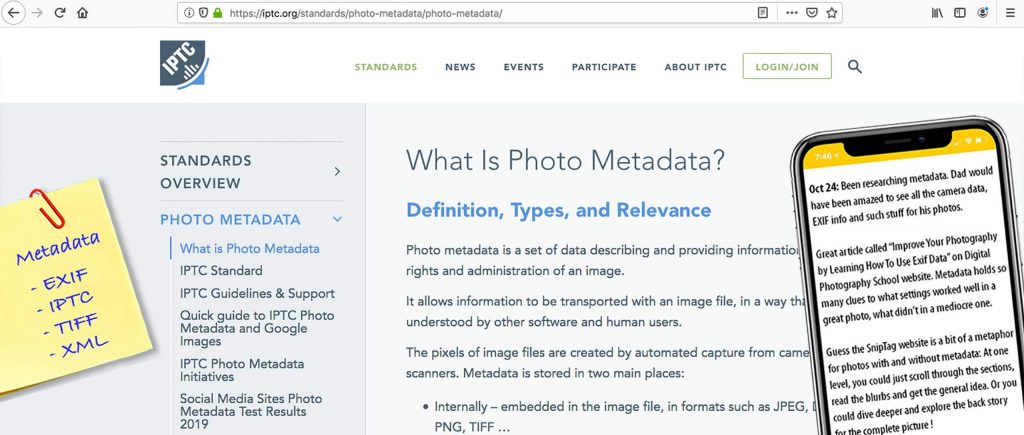Why Edit Image Metadata (and How)

Why bother to edit image metadata? Short answer: To make your photos easy findable, and, if you are a professional photographer, to assert your ownership rights over your work.
We all have thousands of photos. Gigabytes worth of digital images in our computers, smartphones, cloud accounts and external drives. It’s a flood of our own making, and we are drowning.
Do You Know Where Your Photos Are?
They are hard to keep track of. Let’s say you’re making a slideshow of your 2015 fall vacation photos. Even if everyone in the family had saved photos to the same computer, it’d be a chore to locate and sort them. It gets harder if you want to make an album of your best 1990s pictures. Your first hurdle would be to gather and scan them.

But then, the bigger question:
Do You Know What’s in Them?
Memories fade faster than photos. If you’re looking at 25 year old photos, chances are you won’t remember all the names, dates, places and other important details. And once you lose the backstory, the photos aren’t that special any more.

So what can you do about it?
Discover the Power of Image Metadata
In the old days, people preserved memories by scribbling notes behind (or worse: directly on) the photos. But for digital photos, there’s a much better, non-destructive way to do this. Using image metadata.
A digital image is basically a matrix of pixels, and each pixel is made up of bytes of data defining the pixel’s color. So a ten megapixel (10MP) photo contains 10 million pixels worth of data.
In addition to pixel data, every digital photo can hold huge amounts of invisible, embedded data describing the photo. This ‘data about data’ is metadata. And it’s invaluable in searching for and organizing photos.
Types of Image Metadata
There are two broad types:
- EXIF (Exchangeable Image File), which digital cameras automatically embed into photos. This is mostly technical information e.g. camera make and model, pixel dimensions, date, aperture, focal length, shutter settings etc. EXIF data should generally not be modified.
- IPTC (International Press Telecommunications Council) metadata tags store descriptive and administrative information such as location, description (or caption), headline (or title), keywords, photographer’s contact and copyright details etc. IPTC data is supplied by the photographer, and added manually.
An expanded version of IPTC metadata standards is XMP (Extensible Metadata Platform), created by Adobe.
Hundreds of IPTC metadata tags are available, but most of us will only need Date and Time Created, Location, Description and Keywords. In addition to these, professional photographers should also fill administrative tags, e.g. personal profile, licensing and copyright information.
How does Image Metadata Help?
Photo programs such as Photos for Mac, Picasa and Flickr use metadata to organize, sort and provide search results. Google Image Search, Bing Image Feed and other search engines also identify and display relevant search results based on photo metadata.
Adding locations, descriptions and keywords greatly simplifies searching for photos. With photo metadata-enriched images, tasks such as finding all your 2015 photos or your best 1990s photos can be completed in seconds instead of hours. Renaming photos from the camera-generated ‘IMGXXX’ to, e.g., ‘Spain vacation’ can make your photo library ‘human friendly’.

Once you’ve got metadata in your photos, you’ll find many uses for it. Can’t recall the location of that fabulous seafood restaurant in Maine, but have a photo of the lobster bisque you ate? Search for ‘Maine’, and once the photo pops up, check its metadata. Can’t remember your daughter’s graduation date? Find the photo and look up its metadata.
EXIF metadata is a great way to learn about photography. Examining it – for photos taken by you or photographers you admire – offers clues about photography techniques, what separates good shots from mediocre.
How to Edit Image Metadata?
You can do basic metadata editing on a Mac or PC without using any special app. This article explains how to do it on a Mac. Many popular photo programs also allow limited photo metadata editing. Other options include:
- For Mac users: SnipTag app lets you edit image metadata using the Mac’s keyboard or voice dictation. Its big advantage is the option to add invisible image metadata and visible captions at the same time.
- For Windows and Unix users: Exiftool is powerful and feature-rich program, but requires some tech-savvy.
More technically inclined users can find a few more options in this article.